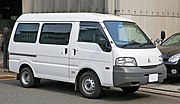Mitsubishi Delica
| Mitsubishi Delica | |
|---|---|
 | |
| Overview | |
| Manufacturer | Mitsubishi Motors |
| Production | 1968–present |
| Body and chassis | |
| Class | Minivan (1968–present) Pickup truck (1968–1994) |
| Body style | Van (1968–present) Pickup truck (1968–1994) |
| Layout | Front-mid engine, rear-wheel-drive (1968–1994) Front-mid engine, four-wheel-drive (1979–1994) Front-engine, rear-wheel-drive (1994–2007) Front-engine, front-wheel-drive (2007–present) Front-engine, four-wheel-drive (1994–present) |
The Mitsubishi Delica is a range of vans and pickup trucks designed and built by the Japanese automaker Mitsubishi Motors since 1968. It was originally based on a cabover van and pickup truck introduced the previous year, also called the Delica, its name a contraction of the English language phrase Delivery car.[1] This pickup truck, and a commercial van derived from it has received many names in export markets, being sold as the L300 (later L400) in Europe, Jamaica (discontinued after the third generation) and New Zealand, Express and Starwagon in Australia, and plain Mitsubishi Van and Wagon in the United States. The passenger car versions were known as Delica Star Wagon from 1979 until the 1994 introduction of the Delica Space Gear, which became simply Space Gear in Europe at least. The most recent version (not available as a commercial vehicle) is called the Delica D:5. With the exception of the first, versions of all generations are still being sold in various international markets.
In Japan, the Delica Cargo nameplate was used on rebadged Mazda Bongo Brawny between 1999 and 2010. Since 2011, the Delica D:3 name has been applied to the rebadged Nissan NV200, and since 2011, the Delica D:2 name has been applied to the rebadged Suzuki Solio.
First generation (1968)[]
| First generation | |
|---|---|
 | |
| Overview | |
| Also called |
|
| Production | 1968–1979 |
| Assembly | Japan: Nagoya (Nagoya Plant) Indonesia: Pulo Gadung, East Jakarta (PT Krama Yudha Ratu Motor) Philippines: Cainta |
| Body and chassis | |
| Body style | 3-door van 2-door pickup |
| Layout | front-mid engine, rear-wheel-drive |
| Related |
|
| Powertrain | |
| Engine |
|
| Dimensions | |
| Wheelbase |
|
The production of the Delica light commercial cab-over pickup began in July 1968.[3] It received the chassis code T100, in line with the recently (January 1968) introduced "T90" Canter. Using a KE44 1,088 cc engine producing 58 PS (43 kW), its maximum payload was 600 kg (1,323 lb) and had a top end speed of 115 km/h (71 mph). A year later, in line with consumer needs, a cargo van and a passenger van were added to the line-up. The passenger van, discontinued in 1976, was called the 'Delica Coach' and could seat nine people in three rows of seats. The engine was upgraded to 62 PS (46 kW) in 1969.
In March 1971, a slightly facelifted version, called the Delica 75, arrived. This (the T120) received a small grille rather than the naked metal front of the earliest Delicas, and a new 1.4-liter Neptune (4G41) engine rated at 64 kilowatts (86 hp) was added to the line-up. The smaller 1.1-liter engine may have remained available in a 600 kilograms (1,300 lb) version of the truck but if so, it soon vanished entirely.[4]
After a fall 1974 facelift, the Delica received a new nose with much plastic cladding and double headlights, now mounted beneath the swage line. It was now known only as the "Delica 1400", as this was the only engine with which it was available (mention of a Delica 1200 is most likely apocryphal, perhaps an issue of confusion arising from the "120" chassis code). A longer wheelbase (T121) one-ton truck was added in 1976.[4]
In export markets, this car was usually called simply the Colt T100/T120. It became a massive success in Indonesia, where "Colt" became synonymous with minibus. Mitsubishi dominated the market and the T120 remained in production until 1982. The nametag was revived in February 1991 with a rebadged version of the Suzuki Carry Futura.[5] Record, a Greek manufacturer of agricultural vehicles, plagiarized the Delica T120 design (even using the same windshield) for their fibreglass-bodied "GS2000" truck.[6]
1975–1979 Colt T120, equivalent to Delica 1400 (Indonesia)
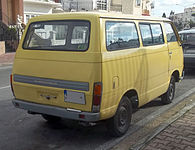
Late Colt T120 van (Malta)
Second generation (1979)[]
| Second generation | |
|---|---|
 Mitsubishi L300 pickup (pre-facelift, New Zealand) | |
| Overview | |
| Also called |
|
| Production |
|
| Assembly |
|
| Body and chassis | |
| Body style |
|
| Layout |
|
| Powertrain | |
| Engine |
|
| Transmission | |
| Dimensions | |
| Wheelbase |
|
| Length |
|
| Width |
|
| Height |
|
| Curb weight | 930–1,165 kg (2,050.3–2,568.4 lb) (RWD) |
The Delica series was replaced in June 1979 by an all new design, bringing overall width up to the maximum 1,690-millimetre (67 in) dictated by Japanese regulations for "compact" vehicles.[11] Suspended at the front by an independent wishbone construction and a leaf spring at the rear, the Delica also features sliding side doors and one-piece gas strut tailgate.[7] The line-up was expanded to include ten model variations encompassing a wide variety of passenger (eight seats in a three/two/three configuration[12]), cargo and recreational applications. A four-wheel drive option was made available in 1982, a first in the Japanese van market. Engines were all four-cylinders well known from MMC's passenger cars and included the 1,439 cc, 80 PS (59 kW) Saturn (4G33) and 1.6-liter Saturn (4G32) engines. A 1.8-liter Sirius (4G62) version producing 100 PS (74 kW) appeared in May 1980, and a 2.0-liter Sirius (4G63B) petrol version became optional in 4WD versions from November 1983.[13] A 2.3-liter Astron (4D55) diesel appeared in October 1982 and was replaced by the larger 2.5-liter Astron (4D56) in 1986.
The four-wheel drive version of the Delica was first introduced to the Japanese market in October 1982.[13] This versatile vehicle utilized a modified version of the Mitsubishi Pajero's chassis, albeit usually with smaller engines (originally only the 1.8-liter petrol).[12] After the introduction of the third generation Delica, the truck (separate cab) version of the second generation continued to be built until 1994. Japanese consumers were liable for higher amounts of annual road tax due to the larger engines installed in higher trim level packages.

Pre-facelift Mitsubishi L300 van (Chile)
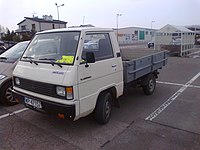
Mitsubishi L300 pickup (Europe)

Mitsubishi Delica pickup (Japan) with double rear tires intended for heavier payload duty

Mitsubishi L300 Star Wagon 4-door high roof van (New Zealand)

Mitsubishi L300 converted to a recreational vehicle (Europe)
Markets[]
Australia[]
Chrysler Australia introduced the SA series Delica to the Australian market on 14 April 1980 under the name "Chrysler L300 Express" after debuting at the Adelaide Motor Show in 12 April.[12][14] After acquiring control of the Chrysler Australia operations in the same month,[15] Mitsubishi Motors renamed the firm Mitsubishi Motors Australia in October 1980.[16] This resulted in the rebranding of the L300 Express as a Mitsubishi.[12] Fitted with a 1.6-liter engine and four-speed manual, both van (three-seater commercial) and wagon (eight-seater) variants were offered, with the commercial (van) version available with or without side rear windows.[12][17] The utility (pickup) version was not sold in Australia, as the L200 Express covered that segment of the market.[12] In November 1981 the SB series was introduced, now fitted with radial ply tires on larger diameter wheels, thus increasing the payload capacity from 925 to 1,000 kilograms (2,039 to 2,205 lb).[12] The following month, Mitsubishi introduced the high-roofed luxury "Deluxe" trim, fitted with electric sunroof and cloth upholstery.[12] The next update to the SB series arrived in October 1982, resulting in the "Deluxe" trim being renamed "Starwagon" and gaining a larger 1.8-liter engine—offered with a five-speed overdrive manual or optional three-speed automatic.[12] The "Star Wagon" (this was written either as one or as two words) moniker was also used on examples assembled by Todd Motors in New Zealand, albeit with the 65 PS (48 kW) 1.6-liter engine.[18] Mitsubishi extended the availability of the 1.8-liter engine to the lower-specification variants, albeit in automatic guise only.[19] The 1.8 was also available in the long wheelbase, high roof, panel van version.
From May 1983, the L300 Express received rectangular headlights in chrome surrounds as part of the SC iteration.[12] The SC also featured newly designed black resin bumpers and adjustments to the front suspension spring rate to improve ride and handling.[20] The four-wheel drive version, badged "4WD", came in October 1983 as a 1.8-liter model with floor-mounted five-speed manual only, therefore becoming a seven-passenger model by losing the front-row center seat.[12][21] After another facelift in October 1984, the car became the SD series, introducing better equipment and black headlight surrounds along with a black trim piece between the headlights on "Starwagon" and "4WD" trims.[22][23] The SD revision also upgraded the "4WD" to a 2.0-liter engine, with the 1.8-liter standard issue in a new long-wheelbase commercial (van) model.[22] A final minor update, the SE series appeared in 1986.[24]

1982 Mitsubishi L300 Express van (SB, Australia)

Mitsubishi L300 Express high roof van (SB, Australia)

1985 Mitsubishi L300 Express panel van (SD, Australia)

1985 Mitsubishi L300 Express 4WD van (SD, Australia)
Asia[]
- Philippines
This generation has been produced in the Philippines since 1987 as the "Mitsubishi L300 Versa Van" (discontinued in April 2012) as well as the Cab/Chassis variant where local coach builders assemble rear bodies for passenger and cargo hauling purposes. Variations such as the FB (family business), PET (personal and equipment transport), WT (water tight aluminum van) and DS (drop side) have been made to cater to those needs. In 2010, an extended rear body variant for the FB variant called the Exceed was added. In 2014, local truck body manufacturer Centro Manufacturing launched a minibus version of the L300 called the XV Mikrobus. It is built on the FB Exceed platform and is meant to be used as a public utility vehicle, a school bus, or an ambulance. It is also meant to revive the Versa Van and to be an alternative to the FB variant.[25] In 2017, Mitsubishi Motors Philippines announced that the L300's diesel engine will be updated to comply with the Euro 4 standardization project of the DENR and the LTFRB.[26][27][28] In April 2019, Mitsubishi Motors Philippines announced that the L300 would be fitted with the 4N14 CRDi engine.[29] From 1987 to 2009, the design of the front fascia haven't changed much for 22 years (although there were minor changes to the interior). The L300 received a facelift in 2010 and was sold until 2017. Mitsubishi updated the styling of the L300 for the 2019 model year, now featuring the new horizontal chrome grille similar to the "Dynamic Shield" design language found on other Mitsubishi models like the Mitsubishi Xpander, Mitsubishi Montero Sport to distinguish it from older L300s.
In 2020, the local production of the L300 reached 200,000 units,[30] and exports has been said under consideration.[31]

Mitsubishi L300 Versa Van (pre-facelift; Philippines)
L300 FB Deluxe (rear view; pre-facelift)
2010–2017 Mitsubishi L300 Prisoner Van coachbuilt by Centro Manufacturing (first facelift; Philippines)

2019 Mitsubishi L300 (second facelift; Philippines)
- Indonesia
This generation is still in production in Indonesia as the Colt L300,[32] equipped with the 2.5-liter 4D56 diesel engine. A petrol engine was also available for a short period, but due to lack of demand, it was discontinued. Since 2010, Isuzu Indonesia have sold this second generation Delica as the Isuzu Bison—available in pickup and minibus versions with an Isuzu Panther-sourced 4JA1L 2.5-litre diesel engine with 80 PS (59 kW). The Bison costs a bit more than a corresponding L300.[33] The production of the L300 was moved from the former PT Krama Yudha Ratu Motor (KRM) plant in Pulo Gadung, East Jakarta to the new Mitsubishi Motors Cikarang plant in Bekasi, West Java beginning in April 2018. In April 2018, the Isuzu Bison was discontinued due to lack of demand and later replaced by Isuzu's fully developed Traga.

Pre-facelift Mitsubishi Colt L300 pickup (Indonesia)

First facelift Mitsubishi Colt L300 Star Wagon coachbuilt by Karya Logam (Indonesia)

Second facelift Mitsubishi Colt L300 Diesel pickup (Indonesia)

Rear view

Isuzu Bison (Indonesia)
- South Korea
In South Korea, Hyundai built the second generation Delica as the "Hyundai Porter", replacing an earlier model with the same name. South Korean production of this Porter continued alongside the third generation Delica, which was marketed by Hyundai as the "Grace". This Porter was replaced by an indigenously developed third generation Porter in March 1996.

Hyundai Porter (Chile)
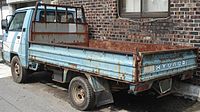
Hyundai Porter (South Korea)
- India
From 1997 to 2000, the car was sold by Mahindra & Mahindra in India as the "Mahindra Voyager", but priced too high it was taken out of production after only a little over two years.[34] The Voyager did meet with some success as an ambulance and as a cargo van, but this association only further prevented prospective private purchasers. Unique to the Mahindra Voyager is the fitment of PSA's 2.5-liter XD3P diesel engine, producing 72.5 PS (53 kW) DIN at 4000 rpm.[35]
Third generation (1986)[]
| Third generation | |
|---|---|
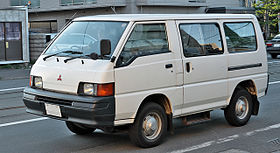 A Mitsubishi Delica 4x4 van | |
| Overview | |
| Also called | Mitsubishi L300 Mitsubishi Express (Australia) PO5 (Sri Lanka) Mitsubishi Starwagon (Australia) Mitsubishi Versa Van Mitsubishi Van/Wagon (US)[32] Dodge 1000 (Mexico) Hyundai Grace Hyundai H-100 Mitsubishi L300 Exceed (Philippines) Soueast Delica (China) Wanli Grace WLZ6470 (China) Sanxing SXZ6441 (China) CMC D260 (Taiwan) CMC D270 (Taiwan) |
| Production |
|
| Assembly | Japan: Nagoya (Nagoya Plant) South Korea: Ulsan Philippines: Cainta Taiwan: Taipei (CMC) Venezuela: Caracas China: Fuzhou (Soueast Motors) |
| Body and chassis | |
| Body style | 2-door pickup 4-door van/minibus |
| Layout | Mid engine, rear-/four-wheel drive |
| Platform | P01V–P35W |
| Powertrain | |
| Engine |
|
| Transmission | 4-speed automatic 5-speed manual CMC (2019): 5-speed automatic 6-speed manual |
| Dimensions | |
| Wheelbase | 2,235–2,435 mm (88.0–95.9 in) |
| Length | 4,380–4,780 mm (172.4–188.2 in) 4,945–4,952 mm (194.7–195.0 in) (Soueast Delica) |
| Width | 1,690 mm (66.5 in) 1,695 mm (66.7 in) (Soueast Delica |
| Height | 1,840–1,955 mm (72.4–77.0 in) 1,970 mm (77.6 in) (Soueast Delica) |
| Chronology | |
| Successor | Hyundai Grand Starex / Hyundai H1 (South Korea) |
In June 1986, the Delica underwent its third full model change. More aerodynamic than previous versions, its monocoque body and extensive safety features proved very popular in Japan's fast-growing recreational vehicle market segment. The more rounded design was referred to as "soft cube" styling by Mitsubishi.[36] Passenger versions continued to be sold as Delica Star Wagon, which became just plain "Starwagon" in Australia. The commercial version is called the "Express" in Australia. Two wheelbases have been offered.[37] In 1990, the Australian market received the naturally aspirated diesel engine as an option; this was the first Delica so equipped in that market.
Although the subsequent L400 Delica and Delica Space Gear were introduced in 1994, production of the Delica Starwagon continued for the Japanese market until 1998. The L300/Delica van versions also remained in production for export markets.[38] These export markets received a facelift in 1999, released in September of that year in Australia. In Japan the commercial Delica range was replaced by a badge-engineered Mazda Bongo under an OEM deal which began in November 1999.
In May 2013, Mitsubishi discontinued the commercial version of the third generation Delica in Australia—badged as the Mitsubishi Express—due to its inferior safety. The Express was the last new car to be sold in Australia with a one-star ANCAP rating. The Express had changed little since it received a minor model change in 2003.[39]
A large range of engines were available, from a 1.4-liter up to a 2.4-liter petrol, and also a 2.5-liter diesel and turbodiesel, plus a 2.6-liter naturally aspirated diesel. Rear- or four-wheel drive, several bodystyles and two different wheelbases made for a particularly extensive line-up. The four-wheel drive chassis was based on that of the contemporary Mitsubishi Pajero, although parts are seldom interchangeable. Late general export market versions received a carburetted 16-valve version of the 2.0-liter 4G63 four-cylinder, with 116 hp (87 kW) at 6,000 rpm.[37]
Markets[]
Asia[]
Cargo versions are built by the China Motor Corporation in Taiwan.[40] This generation Delica was also built under license by Hyundai of South Korea, where it was called the "Hyundai Grace" or "Hyundai H-100" in some Eurasian markets. Launched in December 1986, this version originally received the twin headlights as used in the US market versions, but after a front-end facelift the new more aerodynamic version received thinner and more rounded headlights. This version was called the "New Grace". Both the 2.4-liter petrol and 2.5-liter turbodiesel inline-four engines were available, both Mitsubishi designs. Hyundai terminology resulted in the 4D56 diesel engine being renamed D4BX / D4BA. It takes two more minor changes at each 1996 and 2002, production ended in end of 2003. In 1996, the Delica was also rebadged under the Soueast brand, which occurred through 2013. In the Philippines, this generation of the Delica was called the "L300 Exceed" to differentiate itself to the ageing second generation L300 Versa Van which was still being sold there at that time, and was introduced starting from 1997. Although prior to that, Hyundai has already been selling it's pre-facelift rebadged sibling, the Hyundai Grace since the start of the 1990s.
Mitsubishi Delica Star Wagon (Japan, facelift)
Pre-facelift Mitsubishi Delica pickup (Japan)

Pre-facelift Hyundai Grace (South Korea)

2007 Mitsubishi Delica van by CMC (Taiwan)

2007 Mitsubishi Delica van by CMC (Taiwan)

2013 Mitsubishi Delica L300 truck by CMC (Taiwan)

2019 Mitsubishi Delica van by CMC (Taiwan)

2019 Mitsubishi Delica van by CMC (Taiwan)
Hyundai Grace
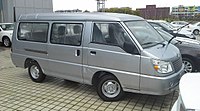
Soueast Delica facelift (China)

Soueast Delica facelift (China)

Delica is imported from Japan to New Zealand for camper van conversion
North America[]
From 1987 until 1990, Mitsubishi sold this model in small numbers in the United States as the "Wagon" for passenger versions and "Van" for windowless cargo versions.[41] The US versions all received a 107 horsepower (80 kW) version of the 2.4-liter 4G64 engine. For model years 1990 and 1991 an LS version of the Wagon was added.[42] Taiwanese-produced CMC Delica vans are sold in Mexico as the Dodge 1000[43] as of July 2007.[44] The Mitsubishi Expo LRV replaced the Van/Wagon in 1992.
Once the fifteen-year minimum age threshold was reached, enthusiasts began importing Japanese domestic market Delicas to Canada. The 4WD turbo diesel van is also a common choice for Canadian postal workers who require a right hand drive vehicle.[45] The United States has a 25-year threshold for importing cars, and recently Japanese domestic market Delicas have begun to gain a following there as well.
Since 2007, the Cargo versions built by the China Motor Corporation in Taiwan are being exported to Mexico wearing Dodge badges.
The Maine Bureau of Motor Vehicles (BMV) is actively de-registering Delicas imported into the United States that were previously registered in Maine under the 25-year federal import rule.

Mitsubishi Wagon (Factory US Model)

1990 Mitsubishi Delica Star Wagon 2.5l Turbo Diesel 4WD - Japanese Domestic Market US Grey import vehicle
Europe[]
This section does not cite any sources. (January 2020) |
Introduced for 1987, the British market received the L300 with either the 1.6- petrol or 2.5-liter diesel engine. Both wheelbases were available. In continental Europe the car was also sold as the L300, with engine options depending on local taxation and market conditions.
Fourth generation (1994)[]
| Fourth generation | |
|---|---|
 | |
| Overview | |
| Also called | Mitsubishi L400 Mitsubishi Space Gear Mitsubishi Starwagon (Australia) Dongfeng Fengxing Lingzhi |
| Production | 1994–2007 2001–2016 (China) |
| Assembly | Japan: Nagoya Philippines: Cainta Taiwan (CMC) China: Guangzhou (Baolong) FAW Freewind (Ziyoufeng) Liuzhou (Dongfeng Liuzhou Motor) |
| Body and chassis | |
| Body style | 4/5-door minivan |
| Layout | Front-engine, rear-wheel-drive Front-engine, four-wheel-drive |
| Related | Hyundai Starex (Design) Dongfeng Fengxing Lingzhi Baolong Pegasus |
| Powertrain | |
| Engine | |
| Transmission | 3-speed automatic with overdrive 5-speed manual China: 6-speed manual 4-speed automatic |
| Dimensions | |
| Wheelbase | 2,800–3,000 mm (110.2–118.1 in) |
| Length | 4,595–5,085 mm (180.9–200.2 in) |
| Width | 1,695 mm (66.7 in) |
| Height | 1,855–2,070 mm (73.0–81.5 in) |
| Curb weight | 1,690–2,170 kg (3,730–4,780 lb) |
1994–1996[]
Released on 12 May 1994, the newest Delica received considerably more aerodynamic bodywork. No truck model was available of this generation, and passenger models were now called Delica Space Gear in the domestic Japanese market. Body specifications of the Space Gear in Japan ranged from XR, XG, Exceed, Super Exceed and Royal Exceed, and both long and short-wheelbase versions were available.

The fourth generation Delica shares its engine and transmission with the Mitsubishi Pajero, but unlike the Pajero of its time it is of monocoque construction and lacks a separate chassis. The Delica 4WD still offers ample off-road capabilities, with four-wheel drive, high and low ratio gears and differential locking. It has engine variations from 2.5 liters through to a 2.8-liter intercooled turbodiesel. 2.4-liter and 3.0-liter V6 petrol engines with 12 or 24 valves are also offered. Apart from the 2.8-liter diesel model all are available as two- or four-wheel drive version.
In many export markets, the cargo versions of the fourth generation were called the Mitsubishi L400 while the passenger versions were called Mitsubishi Space Gear – without using the Delica nameplate at all.
In South Korea, Hyundai used the Mitsubishi Delica as the base vehicle for the Hyundai Starex (A1) manufactured between 1997 and 2007.
In Australia, this generation, known as the WA series was available in both cargo (Mitsubishi Express) and passenger (Mitsubishi Starwagon) versions. The Starwagon was available between September 1994 and 2003. The Express launched at the same time, but continued on until 2005. To differentiate the semi-bonneted WA Express from the cheaper, previous generation SJ series that sold alongside it, the WA models were disambiguated with the "Walk-Thru" designation.[46]
The Australian Starwagons were made available in four levels of specification: GL, GLX, GLS and 4WD.[47] Mitsubishi fitted the GL with a 2.0-liter carburetored inline-four, with the GLX gaining a fuel-injected 2.4-liter inline-four, and the GLS a 3.0-liter V6. Both four-cyliner engines were fitted standard with a five-speed manual transmission with optional four-speed column-shift automatic. The 3.0-liter GLS offered a four-speed floor-mounted automatic as its sole transmission option. The facelift model, released in 1996 saw the range rationalised with only the base GL and mid-range GLX models retained.
1996–2007[]
In 1996, the Delica was upgraded with a facelift model. The upgrade is mostly cosmetic with changes to the lighting clusters and front bodypanel, with the integration of a moulded bumper in place of the original three section bullbar. The engine was upgraded with an electronic control type distribution type jet pump and an electronic sidestep was made standard on the higher specification versions.
A final facelift was released in Japan in August 2002.
2005–2008 Taiwanese facelift[]
In Taiwan, the third generation Delica continued to be produced and sold while the fourth generation Delica was simply named the Mitsubishi Space Gear, and was positioned above the third generation model. Initial versions of the Space gear produced and sold in Taiwan was identical to the series 2 Japanese facelift. However, in 2005 a final facelift was conducted exclusively in Taiwan with minor changes done to the grilles, front and rear bumpers, and front and rear light units.
Delica Cargo (commercial van)
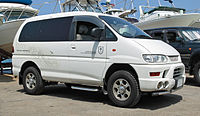
Fourth generation (L400) Delica Space Gear Series 2
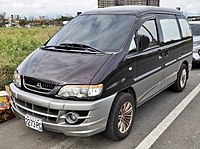
Mitsubishi Space Gear 2005 facelift
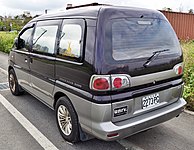
Mitsubishi Space Gear 2005 facelift
China[]
The Dongfeng Fengxing Lingzhi is a range of MPVs produced by Dongfeng Liuzhou Motor under the Dongfeng Fengxing sub-brand. At launch, the Fengxing Lingzhi was essentially a rebadged third generation Mitsubishi Delica or the Mitsubishi Delica Space Gear. The Delica platform was acquired from Taiwan's China Motor Corporation, a partner of Mitsubishi Motors. Therefore, the initial facelifts from Dongfeng Liuzhou were identical to the Taiwanese China Motor Corporation built Mitsubishi Space Gear. After the China Motor Corporation built Mitsubishi Space Gears were discontinued in Taiwan, Dongfeng Liuzhou continued the production in China and conducted their own facelifts and development of the model.[48]
Three trim levels were developed after the facelift by Dongfeng Liuzhou was conducted, including the Lingzhi M5, M3, and V3, which targets different groups of consumers and were priced differently. The M5 is the premium version, featuring a restyled front DRG and restyled tail lamps with prices ranging from 77,900 yuan to 98,900 yuan. The M3 being the basic passenger version sharing the same front DRG design and same tail lamps with the V3 but with clear DLO with prices ranging from 55,900 yuan to 71,900 yuan. The V3 is the utility cargo version with a sealed cargo area and being the most affordable of the three trim levels with prices ranging from 55,900 yuan to 66,900 yuan. Each trim is available with a long wheelbase version called the Lingzhi M5L, M3L, and V3L respectively all sharing the same tail lamp design.[49]

Baolong Pegasus

Dongfeng Fengxing Lingzhi (Mk1)
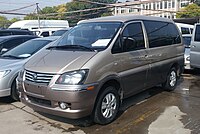
Dongfeng Fengxing Lingzhi (Mk2)
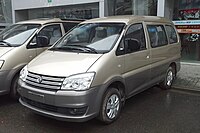
Dongfeng Fengxing Lingzhi (M5)

Dongfeng Fengxing Lingzhi (M5) facelift

Dongfeng Fengxing Lingzhi (M5L)
Fifth generation (2007)[]
| Fifth generation | |
|---|---|
 Mitsubishi Delica D:5 (Japan, pre-facelift) | |
| Overview | |
| Production | 2007–present |
| Assembly | Japan: Sakahogi, Gifu (Pajero Manufacturing Plant) |
| Body and chassis | |
| Class | Minivan/Large MPV |
| Body style | 5-door van |
| Layout | |
| Platform | Mitsubishi GS platform |
| Related | Mitsubishi Outlander |
| Powertrain | |
| Engine |
|
| Transmission | CVT INVECS-III automatic (petrol) 6-speed automatic 8-speed Aisin AWF8F automatic |
| Dimensions | |
| Wheelbase | 2,850 mm (112.2 in) |
| Length | 4,730 mm (186.2 in) (pre-facelift) 4,800 mm (189.0 in) (2019 facelift) |
| Width | 1,795 mm (70.7 in) |
| Height |
|
| Curb weight |
|
On 30 October 2006, Mitsubishi Motors announced that the next generation of its monobox (one-box) minivan would be called the Delica D:5, based on the Concept D-5 prototype first exhibited at the 39th Tokyo Motor Show in 2005.[50] It is an eight-seater, that features Mitsubishi's AWC four wheel drive system and an INVECS-III continuously variable transmission, coupled to a 4B12 2.4 L MIVEC inline-four engine. Based on a new global GS platform, new Delica features Mitsubishi's next-generation RISE safety body. A 2.0-liter version of this engine is also available.
It was released in Japan on 31 January 2007, with prices ranging from ¥2,614,500 to ¥3,412,500.[51]
Available for January 2013 is the clean diesel variant of the D:5, which comes with Mitsubishi's brand new 2.2 L 4-cylinder turbo diesel engine (4N14) that produces 148 PS of power and 360 Nm of torque. Mitsubishi claims that this new 4N14 diesel engine is reliable at low revs and smooth acceleration until high revs. With reduced pressure and temperature in the cylinder, it achieves a low compression ratio of 14.9. The Mitsubishi Delica D:5 with Clean Diesel engine has a fuel consumption of 13.6 km/L based on JC08 Mode cycle.[52]
The Delica D:5 was officially sold in Indonesia between 2014 and 2019, where it was imported from Japan. It was launched on 18 September 2014 at the 22nd Indonesia International Motor Show.[53] It is only available in FWD petrol engine variant based on 2.0 G Power Package 2WD trim with seven-seater seating configuration.
Mitsubishi Delica D:5

Mitsubishi Delica D:5 Roadest

Mitsubishi Delica D:5 Active Gear

Mitsubishi Delica D:5 Active Gear
2019 facelift[]
The 2019 facelift Delica D:5 was unveiled in Japan on 21 November 2018 with "Dynamic Shield" design language, having a 10.1-inch infotainment system and e-Assist.[54] It made its debut to the public at the 2019 Tokyo Auto Salon and was released in Japan on 15 February 2019.
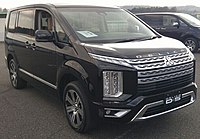
2019 Mitsubishi Delica D:5 2.2 DI-D

2019 Mitsubishi Delica D:5 2.2 DI-D
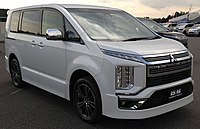
2019 Mitsubishi Delica D:5 Urban Gear 2.2 DI-D

2019 Mitsubishi Delica D:5 Urban Gear 2.2 DI-D

Interior
Other models using the name[]
Mitsubishi Delica Truck/Van/Cargo (rebadged Mazda Bongo Truck/Van/Brawny)[]
Between November 1999 and October 2011 (the Delica Cargo was discontinued in August 2010), Mitsubishi Motors retailed a badge engineered version of the Mazda Bongo as the Delica Truck/Van (short wheelbase) and the Delica Cargo (extended wheelbase) in Japan, replacing the cargo versions of the fourth generation Delica in that market.
1999–2011 Mitsubishi Delica Van
1999–2010 Mitsubishi Delica Cargo
Mitsubishi Delica D:3/Delica Van (rebadged Nissan NV200)[]
In October 2011, Mitsubishi Motors replaced the Mazda Bongo-based models with a badge engineered version of the Nissan NV200, sold as the Delica D:3 (wagon models) and Delica Van (van models). The Delica D:3 and Delica Van were discontinued in April 2019.

2011–2019 Mitsubishi Delica D:3
Mitsubishi Delica D:2 (rebadged Suzuki Solio)[]
To complement the larger Delica D:5 minivan, a smaller Delica D:2 mini MPV appeared in March 2011. Equipped with a 1.2 L (1,242 cc) four-cylinder Suzuki K12B engine and a continuously variable transmission (CVT), it is a rebadged Suzuki Solio provided under an original equipment manufacturer deal.[55]
2011–2015 Mitsubishi Delica D:2 (first generation)

2015–2020 Mitsubishi Delica D:2 (second generation)
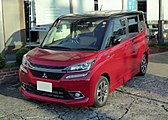
2015–2020 Mitsubishi Delica D:2 Custom (rebadged 2015 Suzuki Solio Bandit)

2021–present Mitsubishi Delica D:2 (third generation)

2021–present Mitsubishi Delica D:2 Custom (third generation) (rebadged 2021 Suzuki Solio Bandit)
Production[]
| Year | Japan | Philippines | Taiwan | China |
|---|---|---|---|---|
| 1995 | 109,930 | n/a | n/a | |
| 1996 | 88,978 | n/a | n/a | |
| 1997 | 69,495 | n/a | n/a | |
| 1998 | 34,614 | n/a | n/a | |
| 1999 | 17,758 | n/a | n/a | |
| 2000 | 28,242 | 2,918 | 8,125 | |
| 2001 | 12,965 | 2,079 | 5,133 | 690 |
| 2002 | 17,456 | 2,925 | 4,192 | 600 |
| 2003 | 13,011 | 3,529 | 5,166 | 13,710 |
| 2004 | 16,432 | 2,826 | 3,862 | 16,074 |
| 2005 | 16,444 | 3,685 | 2,315 | 5,960 |
| 2006 | 16,041 | 3,992 | 1,160 | – |
| 2007 | 14,824 | 4,580 | 1,115 | – |
(Sources: Facts & Figures 2000, Facts & Figures 2005, Facts & Figures 2008, Facts & Figures 2010 Mitsubishi Motors website)
Indonesia (Colt L300)[]
| Calendar Year | Indonesia |
|---|---|
| 2012 | 27,652[56] |
| 2013 | 27,498[57] |
| 2014 | |
| 2015 | |
| 2016 | 20,058[58] |
| 2017 | 20,522[59] |
| 2018 | 21,895[60] |
| 2019 | 28,429[61] |
References[]
- ^ Fact & Figures 2005, p.33, Mitsubishi Motors website
- ^ 自動車ガイドブック [Japanese Motor Vehicles Guide Book] (in Japanese). 25. Japan: Japan Automobile Manufacturers Association. 10 October 1978: 223. 0053-780025-3400. Cite journal requires
|journal=(help) - ^ Ozeki, Kazuo (2007). 日本のトラック・バス 1918~1972 [Japanese Trucks and Buses 1918–1972] (in Japanese). Tokyo: Miki Press. p. 113. ISBN 978-4-89522-494-9.
- ^ Jump up to: a b Kazuhiko. 初代デリカ(T系) [First Delica (T-series)]. Delica History (in Japanese). Archived from the original on 21 July 2011.
- ^ Ruwendo Suswanto, Budiono (21 January 1991). "Nostalgia Raya Jalanan" [Nostalgia for the King of the Road]. Mobil & Motor (in Indonesian). Vol. XX no. 21. PT Informedia Indonesia. pp. 12–13. ISSN 0047-7591.
- ^ Skartsis, Labros S.; Avramidis, Giorgos A. (2003), Made in Greece: Το ελληνικο αυτοκινητο, οχημα και αεροσκαφος [The Greek cars, vehicles, and aircraft] (2nd ed.), Patras, Greece: Typorama and University of Patras Science Park, 2007, p. 177, ISBN 960-7620-30-5
- ^ Jump up to: a b McKay, Peter (June 1980). "Chrysler launches rival for Kombi" (PDF). Modern Motor. Rushcutters Bay, New South Wales: Modern Magazines (Holdings): 15.
- ^ 1987 Ford Husky Van Ad, www.flickr.com. Retrieved 25 June 2015
- ^ Sarne, Vernon (30 May 2013). "Mitsubishi PH president wants new model, more units made in Cainta". Top Gear Philippines. Archived from the original on 14 September 2017.
- ^ "Chinese Car Brands That Time Forgot: Fuzhou Automobile Works and Forta".
- ^ "Delica 1979". Mitsubishi Motors Web Museum. Archived from the original on 16 June 2012.
- ^ Jump up to: a b c d e f g h i j k Mills, Andrew (November 1984). "Mitsubishi L300 Express: The Trendsetter". Modern Motor. Sydney, New South Wales: Australian Consolidated Press: 90–92.
- ^ Jump up to: a b Car Graphic: Car Archives Vol. 11, '80s Japanese Cars. Tokyo: Nigensha. 2007. p. 226. ISBN 978-4-544-91018-6.
- ^ "New vehicles from Chrysler". Victor Harbour Times. 2 April 1980. p. 14. Retrieved 12 September 2016.
- ^ "Australia in the 1980s: Industry". My Place. Australian Children's Television Foundation and Education Services Australia. Retrieved 30 April 2011.
- ^ "Chrysler Australia". Unique Cars and Parts. Retrieved 30 April 2011.
- ^ "1980 Mitsubishi L300". CarBuddy. Archived from the original on 11 September 2011.
- ^ Mitsubishi Star Wagon (brochure), New Zealand: Todd Motors, p. 4, L82222702/NZ
- ^ Lake, Barry, ed. (May 1983). "More power, auto for Express wagon" (PDF). Modern Motor. Sydney, New South Wales: Murray Publishers: 13.
- ^ Lake, Barry (September 1983). "Improved L300 range" (PDF). Modern Motor. Sydney, New South Wales: Murray Publishers: 13.
- ^ "1983 Mitsubishi L300". CarBuddy. Archived from the original on 1 July 2011.
- ^ Jump up to: a b Britten, Tim, ed. (November 1984). "L300 update" (PDF). Motor Manual. Melbourne, New South Wales: Newspress: 8.
- ^ Britten, Tim, ed. (March 1985). "Still king of the people movers?" (PDF). Motor Manual. Melbourne, New South Wales: Newspress: 61–62.
- ^ "1986 Mitsubishi L300". CarBuddy. Archived from the original on 11 September 2011.
- ^ "L300 XV Mikrobus". Top Gear Philippines. Retrieved 21 September 2014.
- ^ "L300 engine update". Top Gear Philippines.
- ^ "Euro 4". Philippine Daily Inquirer. Retrieved 20 January 2016.
- ^ "DENR Euro 4 standardization". Department of Environment and Natural Resources. Retrieved 25 March 2015.
- ^ De Guzman, Marcus (9 April 2019). "This is the 2019 Mitsubishi L300 CRDi Euro-4". AutoIndustriya.com. Retrieved 4 October 2019.
- ^ Laurel, Drei (28 July 2020). "Local production of the Mitsubishi L300 has reached 200,000 units". AutoIndustriya.com. Retrieved 26 April 2020.
- ^ De Guzman, Marcus (30 July 2020). "Mitsubishi PH to export L300 Euro4 to our Southeast Asia neighbors". AutoIndustriya.com. Retrieved 26 April 2020.
- ^ Jump up to: a b "Facts & Figures, Mitsubishi Motors Corporation 2000" (PDF). Section V (Current model lineup), page 6 (Naming in global markets). Tokyo: Mitsubishi Motors. September 2000. p. 18. Archived from the original (PDF) on 22 October 2006.
- ^ Zulkifli, BJ (5 May 2010). "Isuzu Bison Lebih Mahal dari Mitsubishi L300" [Isuzu Bison more expensive than the Mitsubishi L300]. Kompas Otomotif (in Indonesian). KOMPAS.com. Retrieved 29 January 2013.
- ^ https://indianautosblog.com/mahindra-voyager-quanto-vibe-p311913
- ^ "Mahindra Voyager". Mahindra & Mahindra, Ltd. Archived from the original on 23 December 2001.
- ^ "Notable MMC Cars" (PDF). Mitsubishi Motors: Facts & Figures 2010. Mitsubishi Motor Corporation. 2010. p. 31. Archived from the original (PDF) on 16 June 2012.
- ^ Jump up to: a b "L300 – Specification". Bahrain: Mitsubishi Motors. Archived from the original on 24 June 2008.
- ^ "Mitsubishi Facts & Figures 2007 – Mizuma Plant (Japan), Sales figures by volume" (PDF). Mitsubishi Motors Corporation. p. 21. Archived from the original (PDF) on 22 March 2012.
- ^ Hall, Sam (1 May 2013). "Mitsubishi axes Express van over safety". Drive.com.au. Archived from the original on 12 November 2013.
- ^ "China Motor Corporation". Hoovers. Retrieved 21 July 2011.
- ^ James M. Flammang (1994). Standard Catalog of Imported Cars, 1946–1990. Iola, WI: Krause Publications, Inc. p. 447. ISBN 0-87341-158-7.
- ^ Mastrostefano, Raffaele, ed. (1990). Quattroruote: Tutte le Auto del Mondo 1990 (in Italian). Milano: Editoriale Domus S.p.A. pp. 581–582.
- ^ "Aterriza el 1000 en Culiacán". miautoculiacan.com. 24 September 2007. Retrieved 1 April 2018.
- ^ "Ford Lio Ho Motor, Yulon Motor, China Motor in Taiwan planning to expand exports of complete vehicles". Mark Lines. Archived from the original on 15 March 2012.
- ^ "Archived copy". Archived from the original on 3 November 2013.CS1 maint: archived copy as title (link)
- ^ "Changes to Mitsubishi's Walk-Thru Express Van". AutoWeb. 12 May 2004. Archived from the original on 4 March 2016.
- ^ "Mitsubishi Starwagon GLX Car Review". NRMA. 3 December 1994. Retrieved 14 April 2011.
- ^ "Dongfeng Fengxing Lingzhi MPV".
- ^ "東風風行-菱智 Dongfeng Fengxing Lingzhi".
- ^ "New Mitsubishi Motors mono-box minivan to be branded "Delica D:5" Archived 28 March 2009 at the Wayback Machine, Mitsubishi Motors press release, 30 October 2006
- ^ "Mitsubishi Motors launches new Delica D:5"[permanent dead link], Mitsubishi Motors press release, 31 January 2007
- ^ "【三菱 デリカ D:5 クリーンディーゼル 発表】ガソリン車プラス約30万円という価値", Carview, 26 December 2012
- ^ http://www.ktb-mitsubishimotors.co.id/event-gallery/launching-delica-iims-2014-day-1/
- ^ "新型デ���カD:5 スペシャルサイト | デリカD:5 | MITSUBISHI MOTORS JAPAN". デリカD:5 (in Japanese). Retrieved 20 December 2018.
- ^ "三菱自動車、『デリカD:2』 を新発売: ~5人乗り2列シートのコンパクトミニバン~" [Mitsubishi New Release, Delica D:2 – 5 seats in 2 rows in a compact minivan] (in Japanese). Mitsubishi Motors. 24 February 2011.
- ^ "Ini daftar 20 mobil terlaris di 2012" [List of 20 Best Selling Cars in 2010]. Kontan (in Indonesian). Indonesian. 15 January 2013. Retrieved 27 January 2020.
- ^ "Daftar 20 Mobil Terlaris di Indonesia" [List of 20 Best Selling Cars in Indonesia]. Viva (in Indonesian). Indonesian. 23 January 2014. Retrieved 27 January 2020.
- ^ Kuswaraharja, Dadan (1 February 2017). "20 Mobil Terlaris di Indonesia Tahun 2016" [20 of Indonesia's Best Selling Cars in 2016]. Detik.com (in Indonesian). Indonesia: Trans Media. Retrieved 27 January 2020.
- ^ Kuswaraharja, Dadan (17 January 2018). "20 Mobil Terlaris Tahun 2017" [20 of Indonesia's Best Selling Cars in 2017]. Detik.com (in Indonesian). Indonesia: Trans Media. Retrieved 27 January 2020.
- ^ Rayanti, Dina (17 January 2019). "Depak Xpander, Avanza Mobil Terlaris Indonesia Tahun 2018" [Xpander Beaten: Avanza is Indonesia's Best Selling Car in 2018]. Detik (in Indonesian). Indonesian. Retrieved 27 January 2020.
- ^ Rahadiansyah, Rangga (23 January 2020). "20 Mobil Terlaris 2019" [20 of Indonesia's Best Selling Cars in 2019]. Detik.com (in Indonesian). Indonesia: Trans Media. Retrieved 27 January 2020.
External links[]
| Wikimedia Commons has media related to Mitsubishi Delica. |
- Official website (in Japanese)
| show |
|---|
| show |
|---|
| show |
|---|
| show |
|---|
| show |
|---|
| show |
|---|
- Mitsubishi Motors vehicles
- Vehicles introduced in 1968
- 1970s cars
- 1980s cars
- 1990s cars
- 2000s cars
- 2010s cars
- 2020s cars
- Cab over vehicles
- Minivans
- Vans
- Minibuses
- Pickup trucks
- Rear-wheel-drive vehicles
- Front-wheel-drive vehicles
- All-wheel-drive vehicles
- OEM Suzuki vehicles























































